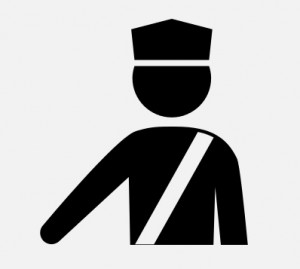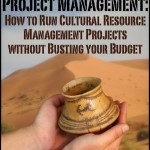 I realized how hard creating a CRM archaeology-specific health and safety plan (HASP) can be while talking about improving archaeology workplace health and safety with my friend (the President of Northwest Safety and Risk Services in Boise, Idaho). In our conversation, I described some of the situations I found myself in during a recent pedestrian survey:
I realized how hard creating a CRM archaeology-specific health and safety plan (HASP) can be while talking about improving archaeology workplace health and safety with my friend (the President of Northwest Safety and Risk Services in Boise, Idaho). In our conversation, I described some of the situations I found myself in during a recent pedestrian survey:
– I started out from the home office and conducted the necessary safety tailgate meeting at the job site.
– We headed to the first point on our survey, which was in a power transmission station. We gained access to the plant and were allowed to work under the transformers and transmission lines without any training, although we did have a guide that told us whenever we were in danger of electrocuting ourselves.
– From there, we headed to a survey segment along the on-ramp of a major urban interstate. We surveyed for about a mile along the shoulder of this heavily traveled corridor.
– Next, we had to survey in a park that was densely occupied by about 20 druggies and otherwise unsavory characters. We walked right through their camps and crossed our fingers that they wouldn’t care (like most stoners, they were oblivious).
– The end of the survey entered a construction zone where large machinery was busy digging 5-foot-deep trenches. Fortunately, we had our hard hats and safety vests, so the construction guys didn’t even notice we were working within about 10 meters of their excavators and deep open trenches.
We also crossed railroad tracks, traversed private property with only a letter of notification, and walked across a 100-year-old garbage dump. And that was all done in about 9 hours along a 2.5 mile corridor.
After describing my day, my amigo said, “Wow. I’ve never had to deal with a job that encounters so many differ hazards each day.” He was dumbfounded. “None of our clients do anything like this. I’m gonna have to think about this one for a while.”
We both agreed that, before we create a template for a CRM HASP, we’ve got to grasp the full spectrum of diversity that CRM work entails.
That wasn’t in the job description
The random hazards we CRM, historic preservation, and heritage conservation specialists face while doing fieldwork is the only thing we do that resembles an Indiana Jones movie. While we can account for the usual hazards (ex. snakes, ticks, open trenches, etc.), there is a constantly changing host of hazards that we can’t plan for. The U.S. Army Corps of Engineers Safety and Health Manual is a about the only HASP that covers the hazards of field archaeology. That’s interesting and somewhat discouraging because the Army has billion-dollar budgets and can afford to plan for every contingency. We are often working under thousand dollar budgets and don’t have the time or expertise to plan for these hazards.
But if the Army can create a health and safety manual that covers peacetime operation, so can some motivated archaeologists.
Build it in bricks
After adopting a culture of safety, I believe considering each job task and the environment in which it takes place is the next step in creating a HASP that covers our bases and can actually keep us safer. These task descriptions and corresponding protocols should be built in blocks of text and procedures that can be welded together whenever a job-specific HASP is necessary.
Consider, for example, a pedestrian survey in the Sonoran Desert of Arizona during the winter. This task will entail a lot of walking over rough terrain, through brush, in areas that don’t have any water. The job will also require off-road driving. Surprisingly, cold may also be an issue, as will cell reception.
With this in mind, we can assume a proper HASP would include information on exhaustion, dehydration, poisonous plants/animals, 4-WD driving, cold-weather health, and non-electronic communication. The company can write up safety information for these hazards and develop policies for working under these conditions. They can save them in a common folder on the company server (or, better yet, on a community Dropbox or Evernote account) and have each field director build a project-specific HASP from these information blocks. A simple worksheet can be created to help the field director identify potential hazards, which would tell her/him what pieces to add to the HASP. The resulting HASP could be turned into a PDF and saved to each crew member’s phone for easy reference. This worksheet can also help the field director collect all the necessary emergency service phone numbers based on where the job is located.
I think this is the best way to handle a field like CRM archaeology that has the potential to come I contact with hazards not seen in other fields. It also prevents us from having to develop overarching, bloated HASPs that try to cover everything under the sun like the Army manual does. Additionally, HASP elements can be added, updated, and improved over time as new information is discovered. It also allows the company to identify areas where their health and safety information is deficient (like safety in an electrical substation).
Sequential action over time is the surest way to initiate change in the way Health and Safety is treated in CRM archaeology, historic preservation, and heritage conservation. Building HASPs in small bricks is the best way to create comprehensive HASPs that address the conditions we face in the field.
If you have any questions or comments, write below or send me an email.
 Small Archaeology Project Management is now on the Kindle Store. Over 300 copies were sold in the first month! Click Here and see what the buzz is all about
Small Archaeology Project Management is now on the Kindle Store. Over 300 copies were sold in the first month! Click Here and see what the buzz is all about
Learn how my résumé-writing knowledge helped four of my fellow archaeologists land cultural resources jobs in a single week!
Join the Succinct Research email list and receive additional information on the CRM and heritage conservation field.


